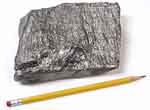Activity 2
Essential Questions
- Why is trade important to a nation’s economy?
- How does global trade influence the lives of people?
Background
Trade occurs because an item with value is available and people, a company, or a country want to obtain it and use it. Sometimes a product is developed that requires many different parts. A computer is a good example. A computer might be assembled in the United States of parts made in other countries. There are the hard drive, internal parts, the keyboard, case, and monitor, for example.

Instructional Strategies
Gathering Information for Problem Solving
Strategy 1 |
Organizing Information Using a Inquiry Record Sheet
- Collect 10 or 12 well-used wooden pencils. They should have a bit of eraser, three or four inches of length, and lead remaining. Away from school, carefully use a cutting device to take the pencil apart. Hexagonal (six sided) pencils are best to take apart since a seam runs on opposite sides and the pencil may split in two. The eraser holder and eraser may be removed and the lead will sometimes come out quite easily. Put all the pieces in an equal number of plastic bags and seal them. The plastic bags of pencil remains will be the exhibit in the inquiry about trade.
- Divide the class into groups of two or three students so that there are enough pencil bags so each group has one. Instruct the students to observe through the plastic bag, but not open the bag. Distribute the bags and pass out the Inquiry Record Sheet.
- Tell the students to develop “inquiry questions” based on the content of the bags. Have them record their questions on the Inquiry Record Sheet.
Have each group report out. Write examples on the board of the questions asked. Get at least one suggestion from each group during the discussion.
End the discussion by asking: Do any of our questions involve trade between two or more places? Draw the attention of the class to the “where” question.
Note: Some examples of questions may be:
- How were the pieces in the bag made?
- Where were they made?
- Are they all made of the same materials?
- How were the pieces in the bag used?
- Did the pieces in the bag go together?
- What did they look like if they were together?
Strategy 2 |
Using Computers to do Research
Explain to the class that they are going to do some further investigating about where the various things are produced that eventually get into a pencil. Tell them that you have discovered a story about the pencil on the World Wide Web.
The story I, Pencil by Leonard E. Read is an informative account of the trade that occurs in making pencils. It may be found at the following website: http://www.econlib.org

Graphite and pencil
- Pencil lead: it is graphite, since lead is a toxic metal. Romans used lead to mark on early forms of paper, and that is why it is still referred to as lead today.
- Ferrule: the metal band that holds the erasure to the wood, made with copper.
- Pumice: a light weight stone that is ejected from some volcanoes; its density is such that it will float on water.
- Fastice: a component of oil seed that is in the erasure and dissolves the graphite and wax so it can be removed by rubbing – the process called erasing.
Establish the following purpose questions for their research:
- What parts of the story talk about trade?
- Do different parts of the pencil come from different places?
Check for Understanding
Follow up the research with these discussion questions:
- Where did of the pieces come from that were in the plastic bags?
- Why is trade important to the production of pencils?
Strategy 3 |
Map Activity: Trading Products to Make Friends
Explain to the class that they are going to use some current information to see if modern day pencils also involve trade.
- Wood: Cedar Trees (California, Oregon, Tennessee, Russia (Siberia)
- Graphite: Sri Lanka, Great Britain, Texas, China, Southern Russia (Siberia)
- Clay: Mississippi, Louisiana
- Wax: Mexico
- Pumice: Italy
- Zinc: Canada (for brass ferrule)
- Copper: Democratic Republic of the Congo, Chile (for brass ferrule)
- Rubber: Indonesia, Sri Lanka, Malaysia
- Seed Oil: Indonesia, Great Britain (for fastice in the eraser)
- Castor Oil: India, Italy, California
- Lacquer: India, China, South Korea, California, Texas, Illinois (yellow paint)
Outline maps of the World and the United States may be printed from the following website:
ASU Maps.
Have the students use the outline maps and information to follow the flow of trade in making a pencil today. Write the following steps on the board for the students to follow.
- Make a key (with a symbol for each of the products that is used to make pencils).
- Label Pennsylvania on the U.S. map as the Pencil Production Plant.
- Identify each location that provides a product on the outline map of the world or the United States.
- Draw movement lines on the maps showing how the products get to Pennsylvania. Label the movement line to indicate when it is land and when it is water transportation.
Check for Understanding
Use the information from the completed maps to discuss this question:
- How does global trade help people and companies make pencils?



